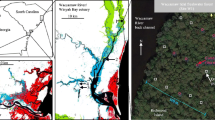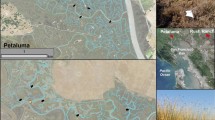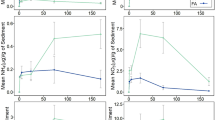Abstract
Two 1-ha riverine wetlands at the Olentangy Wetland Research Park in Columbus, Ohio, USA were constructed in 1993 with a nearly identical geomorphology and have maintained an identical hydrology since their creation. The only initial difference was that one wetland was planted with native macrophytes in 1994 while the other was not. Sediment and nutrient accumulation was evaluated in May 2004, ten years after the wetlands were created. Higher mean sediment accumulation was detected in the deeper open water (OW) zones of both wetlands (6.1 ±0.6 and 7.3 ±0.5 kg m−2 yr−1) than in the emergent (EM) vegetation zones (3.7 ±0.2 and 3.9 ±0.3 kg m−2 yr−1). Directional spatial structure associated with sediment accumulation was detected in both wetlands and was attributed to the greater accumulation in the OW zones and the gradual decrease in accumulation from inflow to outflow. Despite several years of markedly higher productivity in Wetland 2, this wetland showed no evidence of greater organic C accumulation; however, the dense Typha established during those years may have elicited greater deposition and reduced re-suspension of sediment in the OW zones. Large accumulations of Ca (235 ±23 and 235 ±15 kg m−2 yr−1) and inorganic C (71.6 ±6.9 and 70.3 ±4.8 g m−2 yr−1) in the OW zones of both wetlands suggest that CaCO3 deposition has remained a critical process where alga productivity has been highest. Annual rates of sediment and nutrient accumulation for each wetland were lower than those calculated in previous years and typically fall between ranges seen for newly created wetlands and natural wetlands.
Similar content being viewed by others
Literature cited
Anderson, C. J. 2005. The influence of hydrology and time on productivity and soil development of restored and created wetlands. Ph.D. Dissertation. The Ohio State University, Columbus, OH, USA.
Anderson, C. J., W. J. Mitsch, and R. W. Nairn. 2005. Temporal and spatial development of surface soil conditions at two created riverine marshes. Journal of Environmental Quality 34: 2072–2081.
Anderson, K. L., K. A. Wheeler, J. A. Robinson, and O. H. Tuovinen. 2002. Atrazine mineralization potential in two wetlands. Water Research 36: 4785–4794.
AOAC Official Methods of Analysis. 1989. Method 990.03. Protein(crude) in Animal Feed Combustion Method(Dumas method). 17th edition 2002. Reference: JAOAC 72, 770 (1989).
Armentano, T. V. and G. M. Woodwell. 1975. Sedimentation rates in a Long Island marsh determined by 210Pb dating. Limnology and Oceanography 20: 452–455.
Axt, J. R. and M. R. Walbridge. 1999. Phosphate removal capacity of palustrine forested wetlands and adjacent uplands in Virginia. Soil Science Society of America Journal 63: 1019–1031.
Braskerud, B. C. 2001. The influence of vegetation on sedimentation and resuspension of soil particles in small constructed wetlands. Journal of Environmental Quality 30: 1447–1457.
Brenner, M., C. L. Schelske, and L. W. Keenan. 2001. Historical rates of sediment and nutrient accumulation in marshes of the Upper St. Johns River Basin, Florida, U.S.A. Journal of Paleolimnology 23: 241–257.
Brueske, C. C. and G. W. Barrett. 1994. Effects of vegetation and hydrologic load on sedimentation patterns in experimental wetland ecosystems. Ecological Engineering 3: 429–447.
Cahoon, J. C. 1994. Recent accretion in two managed marsh impoundments in coastal Louisiana. Ecological Applications 4: 166–176.
Cahoon, J. C., J. C. Lynch, and A. N. Powell. 1996. Marsh vertical accretion in a southern California estuary, USA. Estuarine, Coastal and Shelf Science 43: 19–32.
Callaway, J. C., R. D. DeLaune, and W. H. Patrick, Jr. 1997. Sediment accretion rates from four coastal wetlands along the Gulf of Mexico. Journal of Coastal Research 13: 181–191.
Cooper, J. R. and J. W. Gilliam. 1987. Phosphorus redistribution from cultivated fields into riparian areas. Soil Science Society of America Journal 51: 1600–1604.
Craft, C. B. 1997. Dynamics of nitrogen and phosphorus retention during wetland ecosystem succession. Wetlands Ecology and Management 4: 177–187.
Craft, C. B., S. Broome, and C. Carlton. 2002. Fifteen years of vegetation and soil development after brackish-water marsh creation. Restoration Ecology 10: 248–258.
Craft, C. B. and W. P. Casey. 2000. Sediment and nutrient accumulation in floodplain and depressional freshwater wetlands of Georgia, USA. Wetlands 20: 323–332.
Craft, C. B., P. Megonigal, S. Broome, J. Stevenson, R. Freese, J. Cornell, L. Zheng, and J. Sacco. 2003. The pace of ecosystem development of constructed Spartina alterniflora marshes. Ecological Applications 13: 1417–1432.
Darke, A. K. and J. P. Megonigal. 2003. Control of sediment deposition rates in two mid-Atlantic Coast tidal freshwater wetlands. Estuarine, Coastal and Shelf Science 57: 255–268.
Davis, S. M. 1991. Growth, decomposition, and nutrient retention of Cladium jamaicense Crantz and Typha domingensis Pers in Florida Everglades. Aquatic Botany 40: 203–224.
DeLaune, R. D. and W. H. Patrick, Jr. 1980. Rate of sedimentation and its role in nutrient cycling in a Louisiana salt marsh. p. 401–412, In P. Hamilton and K. B. Macdonald (eds.) Estuarine and Wetland Processes with Emphasis on Modeling. Plenum Publishing, New York, NY, USA.
Fennessy, M. S., C. C. Brueske, and W. J. Mitsch. 1994. Sediment deposition patterns in restored freshwater wetlands using sediment traps. Ecological Engineering 3: 409–428.
Galvez-Cloutier, R. and J. S. Dube. 1998. An evaluation of freshwater sediments contamination: the Lachine Canal sediments case, Montreal, Canada. I. Quality assessment. Water, Air and Soil Pollution 102: 259–279.
Gee, G. W. and J. W. Bauder. 1986. Particle-size analysis. p. 383–411, In A. Klute (ed.) Methods of Soil Analysis. Part 1. 2nd ed. Agronomy Monograph 9. ASA and SSSA, Madison, WI, USA.
Harter, S. K. and W. J. Mitsch. 2003. Patterns of short-term sedimentation in a freshwater created marsh. Journal of Environmental Quality 32: 325–334.
Horppila, J. and L. Nurminen. 2001. The effect of an emergent macrophyte (Typha angustifolia) on sediment resuspension in a shallow north temperate lake. Freshwater Biology 46: 1447–1455.
Hupp, C. R. and D. E. Bazemore. 1993. Temporal and spatial patterns of wetland sedimentation, West Tennessee. Journal of Hydrology 141: 179–196.
International Standard Organization, ISO. 1995. Soil quality — Determination of organic and total carbon after dry combustion (elementary analysis). International Organization for Standardization 10694:1995(E), Geneva, Switzerland.
Isaaks, E. H. and R. M. Srivastava. 1989. An Introduction to Applied Geostatistics. Oxford University Press, Inc, New York, NY, USA.
Johnston, C. A. 1991. Sediment and nutrient retention by freshwater wetlands: effects on surface water quality. Critical Reviews in Environmental Control 21: 491–565.
Johnston, C. A., S. D. Bridgham, and J. P. Schubauer-Berigan. 2001. Nutrient dynamics in relation to geomorphology of riverine wetlands. Soil Science Society of America Journal 65: 557–577.
Jurinak, J. J. and R. A. Griffin. 1992. Nitrate ion adsorption by calcium carbonate. Soil Science 113: 130–135.
Kadlec, R. H. and J. A. Robbins. 1984. Sedimentation and sediment accretion in Michigan coastal wetlands (USA). Chemical Geology 44: 119–150.
Kang, H., C. Freeman, D. Lee, and W. J. Mitsch. 1998. Enzyme activities in constructed wetlands: Implication for water quality amelioration. Hydrobiologia 368: 231–235.
Kim, J. G. 2003. Response of sediment chemistry and accumulation rates to recent environmental changes in the Clear Lake watershed, California, USA. Wetlands 23: 95–103.
Kleis, B. A. 1996. Sediment retention in a bottomland hardwood wetland in eastern Arkansas. Wetlands 16: 321–333.
Konen, M. E., P. M. Jacobs, C. L. Burras, B. J. Talaga, and J. A. Mason. 2002. Equations for predicting soil organic carbon using loss-on-ignition for north central U.S. soils. Soil Science Society of America Journal 66: 1878–1881.
Koreny, J. S., W. J. Mitsch, E. S. Bair, and X. Wu. 1999. Regional and local hydrology of a created riparian wetland system. Wetlands 19: 182–193.
Liptak, M. 2000. Water column productivity, calcite precipitation, and phosphorus dynamics in freshwater marshes. Ph.D. Dissertation. The Ohio State University, Columbus, OH, USA.
Mcloda, N. A. and R. J. Parkinson. 1980. Soil Survey of Franklin County, Ohio. USDA-SCS. US Government Printing Office, Washington, DC, USA.
Mitsch, W. J., C. J. Anderson, M. E. Hernandez, A. Altor, and L. Zhang. 2004a. Net primary productivity of macrophyte communities after ten growing seasons in experimental marshes. p. 75–78, In W. J. Mitsch, L. Zhang, and C. L. Tuttle (eds.) Olentangy River wetland Research Park at The Ohio State University Annual Report 2003. The Ohio State University, Columbus, OH, USA.
Mitsch, W. J., J. K. Cronk, X. Wu, and R. W. Nairn. 1995. Phosphorus retention in constructed freshwater riparian marshes. Ecological Applications 5: 830–845.
Mitsch, W. J., C. L. Dorge, and J. R. Wiemhoff. 1979. Ecosystem dynamics and a phosphorus budget of an alluvial cypress swamp in Southern Illinois. Ecology 60: 1116–1124.
Mitsch, W. J., N. Wang, L. Zhang, R. Deal, X. Wu, and A. Zuwerink. 2005. Using ecological indicators in a wholeecosystem wetland experiment p. 211–236, In S. E. Jorgensen, R. Costanza, and F. L. Xu (eds.) Handbook of Ecological Indicators for Assessment for Ecosystem Health. Lewis Publishers, CRC Press, Inc., Boca Raton, FL, USA.
Mitsch, W. J., X. Wu, R. W. Nairn, P. E. Weihe, N. Wang, R. Deal, and C. E. Boucher. 1998. Creating and restoring wetlands: A whole-ecosystem experiment in self-design. Bio-Science 48: 1019–1030.
Mitsch, W. J., L. Zhang, C. J. Anderson, A.Altor, and M. Hernandez. Creating riverine wetlands: Ecological succession, nutrient retention, and pulsing effects. Ecological Engineering, 25:510–527.
Mitsch, W. J., L. Zhang, N. Dillon, and D. Fink. 2004b. Biogeochemical patterns of created riparian wetlands: tenthyear results (2003). p. 59–68, In W. J. Mitsch, L. Zhang, and C. L. Tuttle (eds.) Olentangy River wetland Research Park at The Ohio State University Annual Report 2003. The Ohio State University, Columbus, OH, USA.
Nairn, R. W. 1996. Biogeochemistry of newly created riparian wetlands: evaluation of water quality changes and soil development. Ph.D. Dissertation. The Ohio State University, Columbus, OH, USA.
Nairn, R. W. and W. J. Mitsch. 2000. Phosphorus removal in created wetland ponds receiving river overflow. Ecological Engineering 14: 107–126.
Olila, O. G., K. R. Reddy, and D. L. Stites. 1997. Influence of draining on soil phosphorus forms and distribution in a constructed wetland. Ecological Engineering 9: 157–169.
Orson, R. A., R. L. Simpson, and R. E. Good. 1990. Rates of sedimentation in a tidal freshwater marsh. Journal of Sedimentary Petrology 60: 859–869.
Pasternack, G. B. and G. S. Brush. 1996. Sedimentation cycles in a river-mouth tidal freshwater marsh. Estuaries 21: 407–415.
Perry, J. N., A. M. Liebhold, M. S. Rosenberg, J. Dungan, M. Miriti, A. Jakomulska, and S. Citron-Pousty. 2002. Illustrations and guidelines for selecting statistical methods for quantifying spatial patterns in ecological data. Ecography 25: 578–600.
Peterjohn, W. T. and D. L. Correll. 1984. Nutrient dynamics in an agricultural watershed; observations on the role of a riparian forest. Ecology 65: 1466–1475.
Reddy, K. R., R. D. DeLaune, W. F. DeBusk, and M. S. Koch. 1993. Long-term nutrient accumulation rates in the Everglades. Soil Science Society of America Journal 57: 1147–1155.
Richardson, C. J. and C. B. Craft. 1993. Effective phosphorus retention in wetlands: fact or fiction? p. 271–282, In G. A. Moshiri (ed.) Constructed Wetlands for Water Quality Improvement. Lewis Publishers, CRC Press, Inc., Boca Raton, FL, USA.
Selbo, S. M. and A. A. Snow. 2004. The potential for hybridization between Typha angustifolia and Typha latifolia in a constructed wetland. Aquatic Botany 78: 361–369.
Sommers, L. E. and D. W. Nelson. 1972. Determination of Total Phosphorus in Soils: A Rapid Perchloric Acid Digestion Procedure. Soil Science Society of America Proceedings 36: 902–904.
Spieles, D. J. and W. J. Mitsch. 2000a. The effects of season and hydrologic and chemical loading on nitrate retention in constructed wetlands: A comparison of low and high nutrient riverine systems. Ecological Engineering 14: 77–91.
Spieles, D. J. and W. J. Mitsch. 2000b. Macroinvertebrate community structure in high-and low-nutrient constructed wetlands. Wetlands 20: 716–729.
Steiger, J., A. M. Gurnell, and J. M. Goodson. 2003. Quantifying and characterizing contemporary riparian sedimentation. River Research and Applications 19: 335–352.
USEPA. 2005. US EPA Test Methods for Evaluating Solid Wastes. Chapter 5 Miscellaneous Test Methods. Methods 9060A: Total Organic Carbon. SW-846. 3rd edition. U.S. Environmental Protection Agency, Washington, D.C., USA.
Vepraskas, M. J. and S. P. Faulkner. 2001. Redox chemistry of hydric soils. p. 85–105, In J. L. Richardson and M. J. Vepraskas (eds.) Wetland Soils: Genesis, Hydrology, Landscapes and Classification. Lewis Publishers, Boca Raton, FL, USA.
Wetzel, R. G. 2001. Limnology: Lake and River Ecosystems, Third Edition. Academic Press, Inc., San Francisco, CA, USA.
Wu, X. and W. J. Mitsch. 1998. Spatial and temporal patterns of algae in newly constructed freshwater wetlands. Wetlands 18: 9–20.
Zhang, L. and W. J. Mitsch. 2005. Model budgets of the two Olentangy River experimental wetlands in 2003. p. 39–52, In W. J. Mitsch, L. Zhang, and C. L. Tuttle (eds.) Olentangy River wetland Research Park at The Ohio State University Annual Report 2003. The Ohio State University, Columbus, OH, USA.
Zhang, L. and W. J. Mitsch. 2005. Modelling hydrological processes in created wetlands: An integrated system approach. Environmental Modelling & Software 20: 935–946.
Author information
Authors and Affiliations
Additional information
An erratum to this article is available at http://dx.doi.org/10.1672/0277-5212(2007)27[774:E]2.0.CO;2.
Rights and permissions
About this article
Cite this article
Anderson, C.J., Mitsch, W.J. Sediment, carbon, and nutrient accumulation at two 10-year-old created riverine marshes. Wetlands 26, 779–792 (2006). https://doi.org/10.1672/0277-5212(2006)26[779:SCANAA]2.0.CO;2
Received:
Revised:
Accepted:
Issue Date:
DOI: https://doi.org/10.1672/0277-5212(2006)26[779:SCANAA]2.0.CO;2




